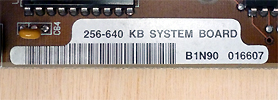| Parent |

| Bank 0: | 256 KB sized, | addressed 00000 to 0FFFF hex | ( 0 KB to 256 KB) (socketed) |
| Bank 1: | 256 KB sized, | addressed 40000 to 7FFFF hex | (256 KB to 512 KB) (socketed) |
| Bank 2: | 64 KB sized, | addressed 80000 to 907FF hex | (512 KB to 578 KB) (socketed) |
| Bank 3: | 64 KB sized, | addressed 90800 to 9FFFF hex | (578 KB to 640 KB) (socketed) |